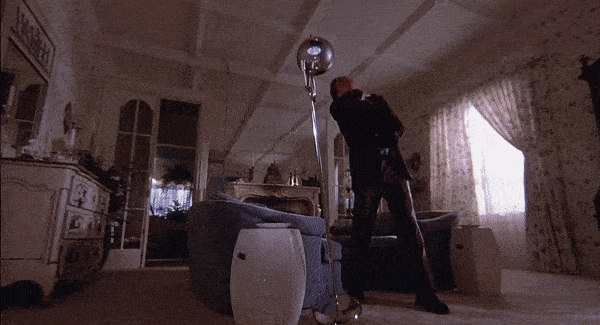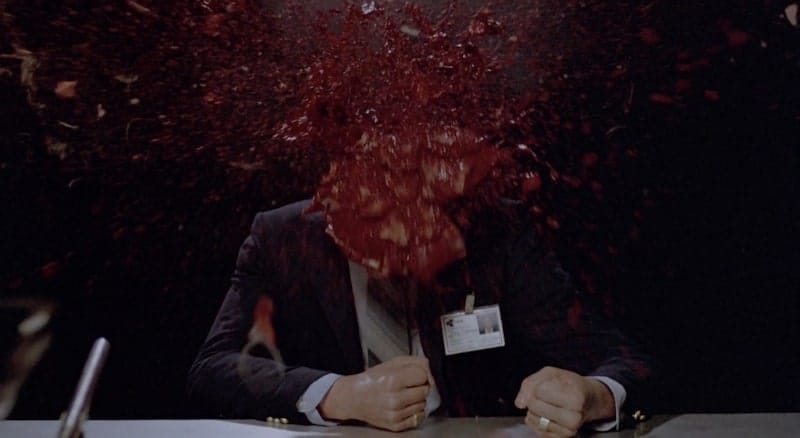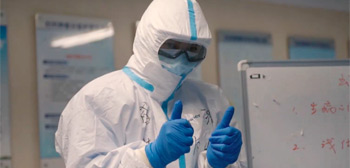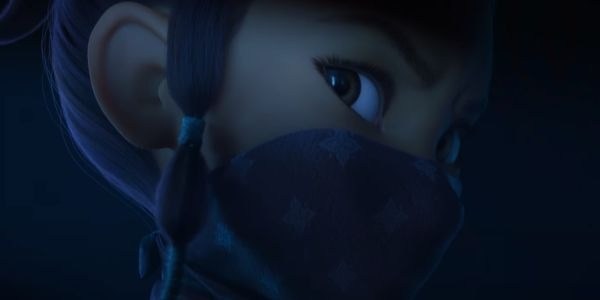How They Shot the Head Explosion Scene in ‘Scanners’
Welcome to How’d They Do That? — a bi-monthly column that unpacks moments of movie magic and celebrates the technical wizards who pulled them off. This entry looks into the head explosion scene in Scanners.
Much like its infamously explosive setpiece, the making of Scanners was a real headache.
With director David Cronenberg hot off The Brood, the abnormal time pressures of the Canadian tax-shelter era rushed Scanners into production without a script. With only two months to wrap principal photography, Cronenberg was forced to write and shoot the film simultaneously, all while managing a hectic production with his biggest budget to-date.
Luckily, Cronenberg’s notorious sense of calm prevailed, and Scanners was a box-office success. As close to a standard sci-fi thriller as Cronenberg ever came, Scanners dodged the genre marketing practices that had consistently worked against him in the past to deliver his first mainstream hit.
Scanners concerns an antisocial derelict named Cameron Vale (Stephen Lack), who is recruited by the mysterious ConSec research agency as one of the world’s few hundred “scanners” — individuals born with remarkable telepathic and psychokinetic abilities. A ConSec doctor named Paul Ruth (Patrick McGoohan) tasks Vale with eliminating the megalomaniacal Darryl Revok (Michael Ironside), a powerful scanner who intends to subjugate humanity, and all scanners who oppose him, with his gifts.
Set alongside the obsessive grotesques of Cronenberg’s earlier work, Scanners is a relatively tame entry from Canada’s Baron of Blood. With one explosive exception: a notoriously gory and shockingly visceral setpiece in the director’s career-long mind/body discourse.
Early in the film, we’re invited to a ConSec marketing event. A scanner (Louis Del Grande) gently declares that he will “scan” every person in attendance, one by one. From behind his thick mustache and even thicker glasses, he calmly explains that the process has been known to hurt a little. With that enticing caveat, he calls for his first volunteer. The people in the crowd exchange hesitant and doubting looks. Finally, a man in the back raises his hand. Unbeknownst to the lecturing scanner, and to us, this man is not supposed to be here. Not only that, this man isn’t just a man. This is Darryl Revok.
Revok descends towards the stage and, with a subliminally menacing air of faux-ignorance, follows the lecturer’s instructions. He focuses his mind. And it quickly becomes apparent that’s not all he’s doing. Something is terribly wrong. As Revok’s face contorts in concentration, the lecturer gasps for air and pounds his fists in discomfort that quickly escalates to agony. The pressure mounts and mounts until finally, abruptly, the lecturer’s head explodes. His face balloons outward, his eyes pop forward, and horribly viscous gore erupts in all directions; a scarlet mushroom cloud of skin, brain, bone, and flesh.

The head explosion in Scanners one of the most alarming and, dare I say, mind-blowing special effects in science fiction. It’s a spectacularly corpulent setpiece and one of the most iconic shots in genre film. How the heck did they do it?
How’d they do that?
Long story short:
The Scanners‘ head explosion was accomplished by blasting a stuffed gelatin head with a high-pressure shotgun loaded with kosher salt.
Long story long:
The exploding head sequence was created by special makeup artist and foam latex expert Chris Walas, who would go on to work with Cronenberg on the creature effects for both The Fly and Naked Lunch.
As director of photography Mark Irwin recalls in the 2014 documentary short The Scanners Way, “The trouble with pyrotechnics is a squib can blow something up but it shows a spark. And if you want this kind of ‘mental pressure,’ you don’t want to see that there’s an ignition…we couldn’t get it quite right.”
Special makeup artist Stephan Dupuis has confirmed this issue. “When [the head] exploded with the explosive, there was a massive amount of smoke,” he recalled to TIFF. “It looked more like the Death Star than, you know, a human head.”
As effects coordinator Gary Zeller recalls, the effect was not originally regarded as a standout setpiece. So the initial approach was pretty simplistic. Namely: make a head, fill said head with air, and give it a pneumatic discharge. “We got this ballooning head that just looked ridiculous,” he remembers.
The variations continued. “We did a plaster head,” explains Dupuis. “Which, of course, looked like a plaster head. Of course, that didn’t work. Then we did a wax one. That looked exactly like a wax head exploding. Although there was a lot of blood and gore.”

Finally, they found a method that looked convincing. “We took a life cast of Del Grande and made a gelatin positive in the mold,” recalls Walas. This was then fitted with a plaster “skull” that acted as both structural support and a vessel for all the goop you see on-screen. “That was packed with various materials… and sealed with wax” Walas explains.
The head was filled with excess materials from the lab, like latex scraps and stray wax. There were also pieces of gelatin “brains” and, as Dupuis puts it, “a bunch of corn syrup blood” as well as “leftover burgers.” While I have my doubts, the rumors that the head contained animal entrails are not impossible considering Cronenberg would make full-use of butcher scraps in his subsequent film, Videodrome, during that film’s explosive finale.

But, back to Scanners. Walas notes that they tried to find “a lot of stringy stuff that we figured would fly through the air a little bit better.”
And speaking of the projectile-like nature of the explosion, at one point, Ironside was supposedly going to be in-frame. As described in the 2014 documentary short Mental Saboteur, when the actor learned what the plan was from the special effects crew (namely: his being in proximity to an explosion), he saw an opportunity.
As Ironside tells it, he noted to the crew that the plexiglass enclosures around the camera were likely to cause debris to ricochet. “And I said: ‘I’ll tell you what, I’ll do it but I want this amount of money and I want this size of an insurance policy. Which quickly made them make the decision to do it as a single.’” Whether Ironside’s ultimatum is the reason the effect was shot without him, I can’t say. But, in any case, it’s a good story.
The lecturer’s hands, which appear clenched and sturdy on the table, are casts of Walas’ hands. He specifies that the rings were an eleventh-hour addition to match Del Grande’s jewelry and recalls they were constructed out of mortician’s wax and the gold wrapper from a pack of cigarettes.
The original plan for the sequence was to shoot on-location at the Concordia University lecture room. Reportedly, the effects team took all the elements to set and realized, per Walas in a gross understatement, that “it might make too much of a mess”. So the sequence was shot later in a government-allocated warehouse on the waterfront of Montreal in the dead of December. Or, as Irwin puts it: “Basically outside.”
Reportedly, on the day of the shoot, nobody could get the Del Grande effigy to explode properly. So, at some point, Zeller boldly proclaimed that he was “through screwing around.” They moved to plan B: a double-barreled shotgun. As Irwin tells it, Zeller told the crew to roll the four coverage cameras, and for everyone else to get in their trucks and close their windows. He then lay on the ground behind the dummy and pointed the shotgun at the nape of its neck, and fired.
“We settled on kosher salt,” explains Zeller, regarding the ammunition of choice. “Just chunky salt particles that were kind of crystalline and not too reflective so it couldn’t read [on-camera] too well. And then when we blasted [the head]…everything just shot all over the place and it looked fabulous. If ever you want to blow up a head, I advise using kosher salt. But don’t do this at home.”
When the producers of Scanners saw the dailies of the head explosion they were both appalled and enthused — reportedly shouting: “It’s perfect! We’re screwed!” The sequence was re-shot three times in an attempt to avoid an x-rating. But, as Irwin recalls, “It was never as good as what was shot originally.” In part because, depending on who you ask, these reshoots were actively sabotaged with, among other things, confetti. In any case, it’s the original kosher salt take that we see in the final film.
While the head explosion is masterful in isolation, the build-up to the effect is a vital part of the shot’s impact.
Howard Shore‘s score (say that ten times fast) mutates from a tonal element to a diegetic representation of “scanning” itself. Wary woodwinds rouse our suspicion as Revok takes to the stage and high-pitched, nearly inaudible strings begin to drone. As Revok scans the lecturer, Shore raises the pitch of the strings and ushers forth a predatory, clicking growl and an unnatural, enveloping throb.
Shore brings all of these elements into cacophony as the pressure mounts, both in the scene and in the lecturer’s head. As the frenzy becomes unbearable, it’s easy for the audience to identify with Revok’s victim as they too begin to wince.

The other element that sells the final explosion is the performance from Del Grande and Ironside. Even during its more effects-heavy scenes, the “scanning effect” in Scanners is heavily dependent on the actors. It is genuinely distressing to watch Del Grande’s visible discomfort, shaking fists, and strained breaths. You buy that this is someone in great mental and physical pain.
For his part, Ironside contorts his face with an air of absolute cool; a terrifying control, and a superiority that he visibly relishes. His head rolls, his brow furrows, and his lips curl into a mocking smirk. “[Cronenberg] created an environment where it was safe to reach for something that you might be a little uncomfortable doing in a different environment,” the actor explains. “I felt like a child who was given permission and the safety to play close to the edge.”
What’s the precedent?
Scanners undoubtedly features cinema’s most infamous exploding head. Indeed, the trope of nuked noggins is prolific. And yet there is perhaps no clearer precursor to the Scanners scene than 1978’s The Fury.
Directed by Brian De Palma, The Fury tells of an ex-CIA agent who employs a young psychic to help him retrieve his telekinetic son from malicious forces. In the film’s final scene, the young psychic Gillian (Amy Irving) blows up the manipulative Ben Childress (John Cassavetes) with her mind. The effect was achieved by using the distraction of a falling lamp to match-cut the actor with a dummy rigged with explosives and blood. The explosion took two takes to get right. It was shot with a high frame-rate camera because De Palma is nothing if not a showman.

Now, there are some who gallantly accuse the head explosion scene in Scanners of ripping off this sequence. To which I say: hold your horses. There are undoubtedly similarities. But from a technical standpoint, these two effects differ critically in execution. A shotgun, quite simply, produces a different effect than the pyrotechnics on display in the gif above. This is a great example of what the Scanners crew meant by “squibs cause sparks.” And, to be blunt, the only thing to survive the explosion in The Fury is Cassavetes’ head. So, checkmate, nerds.
To be clear, I don’t doubt that The Fury was an inspiration for the head explosion in Scanners. But this isn’t a “bad thing.” Influence, after all, is a powerful creative force, not a moral failure as some pedants seem to believe. To imply otherwise… well, it’s enough to make one lose one’s head.






